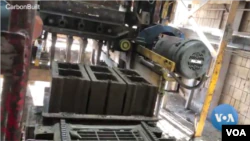Concrete blocks made by a company called Carbon Built are no ordinary concrete blocks. The company produces them by baking in a special kind of oven with the help of a special method. Mr Gaurab Sant, founder of the Carbonbilt Company, said: “These furnaces are a little different from the ovens you use at home. Here we use carbon dioxide through flue gas. Think of the gas emitted from the chimneys of power plants. The same thing we use in these operating ovens, and the last gas that comes out of it is a kind of mixed carbon-di-oxide. ”
That carbon-di-oxide is bound in blocks made by the Carbonbuilt Company. This is important because concrete produces a lot of carbon dioxide. Concrete is a mixture of cement, stone and sand. Limestone is burned at 1500 সেল C to make cement. Flames produce carbon-di-oxide, but hot limestone itself produces more of this gas. Volker Seek, director of the Global CO2 Initiative at the University of Michigan, says one ton of concrete produces one ton of carbon-dioxide gas, and its demand continues to grow with the growing population.
“We have a problem if we can’t find ways to make concrete more effective,” said Volker Sick, director of the Global Carbon-Dioxide Initiative at the University of Michigan. Carbonbuilt is one of several companies that have come up with a more effective way to change their technology so that cement can absorb carbon dioxide gas.
Jennifer Wagner, president of CarbonCure, says that this method can do more than just reduce the presence of carbon dioxide in the atmosphere. She says, The desired strength of concrete can be achieved by adding dioxide and cement is considered to be the most carbon-intensive component of concrete. ” Less cement means less carbon dioxide, and it saves money. It could also help find new customers in the industry, says Miss Wagner. “Everyone wants to make the environment greener, but they don’t want to spend too much money,” said Jennifer Wagner, president of Carbonkio.
With this technological process, carbon emissions can be reduced by more than half in some cases. CarbonBuilt and CarbonCure, two of these companies, have recently won the Carbon Express for using carbon dioxide gas to make ready-to-sell products on the market. “It’s a good start,” said Professor Volker Sick. “I think it’s created new possibilities,” said Volker Seek, a professor of engineering at the University of Michigan. Are we ready to make it work everywhere now? One way to solve our problems is to find a way forward. ”
Jennifer Wagner, president of Carbonicure, said: “Right now we have about 300 concrete installations around the world that are using technology every day, there are about a million plants, so we’re really just getting started.”
These technologies have just begun to be applied. A company called Solidia is producing the same pavers of concrete that are needed to build the roads using the same technology.
Concrete is one of the largest and most abundant man-made elements on earth, so we have a long way to go to mitigate its huge impact on the climate, and it will take a lot more time.













